Wind Propulsion Report
Wind Propulsion: A Greener Way to Power Ships and Cut Emissions

Wind Power Could Change How Ships Move Across the Ocean
A new report talks about using wind propulsion systems to help cargo ships reduce fuel use and lower pollution. With many countries trying to fight climate change, this method offers a cleaner and cheaper way to move goods across the sea. Some of these wind-powered solutions include rotor sails, wing sails, suction wings, sailing rigs, and kites. These systems can work with new ships and even be added to older ships already in service. By the middle of 2024, over 105 ships will have wind systems installed.
What Wind Propulsion Systems Can Do for Shipping
Wind propulsion uses natural wind energy to push ships forward. It reduces the need for traditional fuel, which means lower greenhouse gas emissions. This is important because ships release large amounts of pollution into the air. The goal is to cut the shipping industry’s carbon footprint while making operations more affordable.
- Rotor sails look like tall cylinders that spin and help ships move with the wind.
- Wing sails are like airplane wings on ships, catching the wind to create motion.
- Suction wings help direct the airflow around a ship for better efficiency.
- Kites are large sails that fly high above ships, pulling them forward.
- Sailing rigs use multiple sails to harness wind power, just like old-fashioned sailing ships but with modern technology.
These solutions show how wind energy can help reduce fuel use, making shipping both greener and more cost-efficient.
Trailblazing modern sailing ship gets green light from global shipping body
Challenges in Using Wind Systems
Even though wind propulsion systems sound promising, the shipping industry faces some challenges in adopting them:
- High upfront costs: Installing wind systems on ships can be expensive, making some companies hesitant.
- Regulatory hurdles: Rules about how ships operate and are designed must evolve to accept these new technologies.
- Technical difficulties: Each ship is different, so adding wind systems needs careful planning and design to work well.
The report says international cooperation is necessary to make wind propulsion more common. Governments, shipping companies, and technology developers need to work together to solve these problems. New policies and incentives could also encourage more companies to adopt these green technologies.
The Future of Wind-Powered Ships
The report offers hope that wind propulsion can become a game-changer in the shipping industry. It’s not only about helping the environment but also about saving money in the long run. As the world moves toward cleaner energy, wind-powered ships could play a big role in creating a sustainable future. With more installations expected in the coming years, the use of wind technology in shipping is just beginning.
